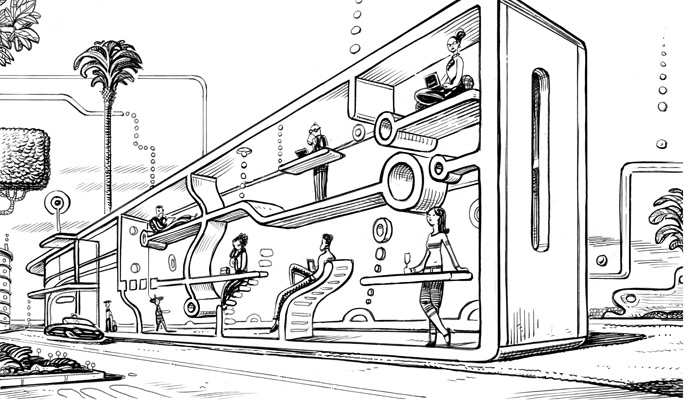The Data-Driven Optimist
Economist Max Roser is compiling an archive of global improvement.
In the year that Jesus of Nazareth was crucified, when Rome controlled about 25 percent of the world’s population, global GDP per capita was the equivalent of US$463 in 1990. Roughly one thousand years later, around the time of the Norman conquest of England, global GDP per capita actually had decreased by a little more than $10. And about 500 years hence, when Columbus arrived in America, the world’s GDP had ticked up a mere 25 percent. In fact, it wasn’t until 1800 that GDP per capita finally topped $600. These data points suggest that for nearly 2,000 years — and presumably, researchers say, untold millennia before that — the global economy was staggeringly inert.
Then, on the wings of the Industrial Revolution, it suddenly expanded. New technologies, productivity improvements, and cross-border communications, trade, and travel took global GDP per capita to $6,000 in the year 2000; it stands above $7,000 today. This expansion occurred despite (or perhaps in part due to) a concomitant global population boom that has produced a six-fold increase in the number of people on Earth, to 6 billion.
Closely related to these rapid GDP gains is another revealing set of statistics. In 1820, 95 percent of the world lived in poverty; by 1929, that rate had fallen to about 75 percent. In 1980, 50 percent of people survived on less than $1.25 per day; today that percentage has declined by more than two-thirds.
This nuanced data narrative is, in fact, the germ of a larger story that can tell us a lot about overcoming income inequality. It is the handiwork of Max Roser, a research fellow at the Institute for New Economic Thinking at the Oxford Martin School. On two websites — Our World in Data and Chartbook for Economic Equality — Roser has for the past few years posted dozens of charts that provide a long-term empirical timeline for the immense changes related to economic growth.
The inspiration for this project came from a vulnerability Roser observed in some of his fellow economists: Addicted to theory and sometimes to political biases, he says, they avoid hard data or empirical evidence that may inconveniently undermine their points of view. “By minimizing the empirical approach, we deprive ourselves of essential lessons about global and regional change and their catalysts over long periods of time,” Roser told me. “Ideally, data should determine the structure of economic principles rather than be used as an afterthought to support a theoretical point of view.”
Using dozens of sources — many of them extremely obscure — Roser generates a wide trove of information, some of it seemingly unconnected, that combines to elucidate a larger set of conclusions. For example, his data provides indispensible fodder for analyses of the affordability of necessities like light. He examined the price of lighting per million lumen hours in the U.K. from 1300 through 2006, adjusted for inflation. Seven hundred years ago, when tallow candles provided light, a million lumen hours cost £40,000. Today, the price is only £3 around the world. We’ve forgotten how much of a luxury it used to be to see and read at night. This analysis underscores the profound level of poverty in North Korea, which appeared pitch-black in a well-lighted region in a night photo taken by International Space Station astronauts in 2014.
We’ve forgotten how much of a luxury it used to be to see and read at night.
Some of Roser’s most ambitious and controversial work involves income and wealth disparity. Roser has published individual and comparison charts for 25 nations, based on tax returns dating back in some cases to 1900, depicting the percentage of earnings by income strata as well as the percentage above the median for the top 10 percent of earners. The data provides a nuanced picture of income inequality — and an opportunity to dispassionately consider possible remedies.
One example: In English-speaking countries, the share of total income held by the top 1 percent of earners has ballooned since 1990, but most other European nations and Japan have not mirrored that trend. Moreover, during this period many of the English-speaking countries saw huge increases in GDP, stock market valuations, and real estate prices — gains that disproportionally benefit the wealthiest people. In part, that explains the accelerated income expansion for the top 1 percent even as wages fell broadly in English-speaking countries, an essential, if subtle, distinction because income and wages are often mistakenly conflated.
Another chart shows the U.S. adoption of new products and technologies. In the 15 years between 1990 and 2005, cellphone penetration rose from about 2 percent of households to 90 percent; a few years prior, microwave ownership rose at the same rapid pace. But earlier in the 20th century, it took about twice as long for the refrigerator and washing machine to make similar gains. The affordability of mass products often has been noted as a factor mitigating wealth disparity. But the speed of change is often overlooked; accelerating innovation plays a role in improving quality of life.
“One lesson from the empirical research that shows varied levels of inequality in different countries is that we can do something about it,” Roser says. He believes that the crux of the problem in the U.S. can be found in two data points: the higher proportion of poor literacy and numeracy skills among adults in the U.S. than in other countries, and the socioeconomic background that is a determinant of these skills.
Consequently, Roser says that one way to reduce inequality is to target educational efforts regarding the skills and productivity tools that employers most desire, which could have the added benefit of increasing growth at the same time. And, he adds, the price of education must be minimized. “The strong link between skills and family background suggests that increasing costs for education are also enhancing the probability that existing inequality will turn into future inequality,” Roser says. “Simply reducing education costs would make it possible for those from poorer backgrounds to earn higher incomes later in life.”
Roser is an optimist. He says his charts, which cover everything from African development to violent death rates, unambiguously depict a world that is evolving for the better. Food availability and consumption are up dramatically in every region; around the world, child mortality has fallen precipitously. His favorite recent illustration is a table that shows a striking divergence in literacy rates in the Middle East between 15- to 24-year-olds and people over 65. In country after country, the younger generation’s literacy level is about 90 percent or higher compared to the more senior group. When viewed with another Roser chart that shows a strong correlation between high levels of education and democracy, prospects for the Middle East in upcoming decades become more sanguine.
In fact, the only thing that Roser appears to be pessimistic about is whether policymakers will use this type of historical data to help develop sound economic principles and policy. We should be planning for a future in which things get better with measures that equalize and improve education and tax policy and provide support for raising children in all social strata, he says. Pessimism on the part of policymakers “was more understandable 80 years ago when there was not much data and no computers to correlate it,” he says. “We have no excuse now to keep thinking that way.”





